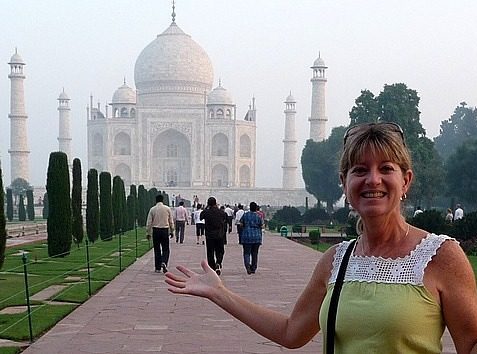So with the SUV repaired, we left the Albanian Alps on Monday morning headed north to Kosovo. The drive took us back along the winding road to Bajram Curri. We then turned north towards the Kosovo border passing farmland and lots and lots of cows either lazing by the side of the road or being herded down the middle of the road.
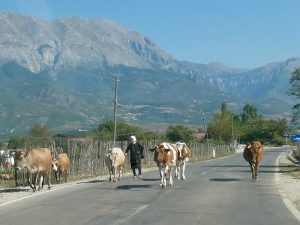
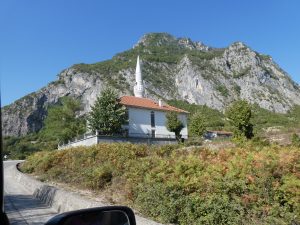
We reached the Kosovo border just about an hour after we left Valbona and then crossed into Kosovo through the border in less than two minutes. I don’t think the guy even stamped my passport. Now while I had made a brief trip through Kosovo on my journey from Macedonia to Albania, that trip was on the major highway through Kosovo. Our trip was taking us on more rural roads. This allowed me to get an up close and personal view of the many, many, many roadside memorials to the young men who were killed in the Kosovo war between February 1998 and June 1999.
The conflict was fought by the forces of the Federal Republic of Yugoslavia (i.e. Serbia and Montenegro), which controlled Kosovo before the war, and the Kosovo Albanian rebel group known as the Kosovo Liberation Army (KLA). In March 1999, with mounting evidence of genocide being committed by the Serbs, NATO commenced air support to assist ground troops provided by the Albanian army. The war ended with the Kumanovo Treaty requiring the Yugoslav and Serb forces to withdraw from Kosovo to make way for international peacekeepers. In 2008 Kosovo gained independence from Serbia and is the newest country in the world.
The war took a terrible toll on the county with over 13,500 ethnic Albanians killed or missing and over a million people were displaced. So the memorials dotting the roadside mark the spot where a person was killed. In some places we passed you could see it must have been the scene of heavy fighting based upon the numerous markers at the site. In other places, there was a single marker.
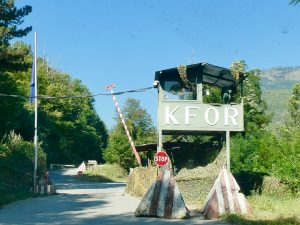
And while the war is over, the presence of NATO forces are everywhere. In fact, our first stop of the day, the Visoki Dečani Monastery in Dečan, required us to pass through a NATO checkpoint. Then at the entrance of the monastery, I learned Gasi was not permitted to enter. Visoki Dečani Monastery is a Serbian monastery (Orthodox Christian) in a ethnic Albanian country that is primarily Muslim. There have been multiple attempts by locals to destroy the UNESCO World Heritage site so NATO forces do not permit ethnic Albanians to enter.
So I would go it alone. I turned over my passport to the very nice NATO officer from Moldova in exchange for a visitors pass, donned a robe to cover my legs and was buzzed in through the gates. I immediately encountered further NATO forces who were watching visitors from a balcony above. Despite the heavy presence of security the grounds felt incredibly peaceful.
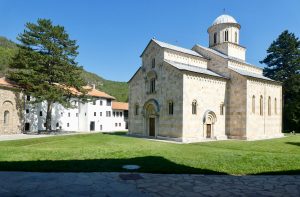
The location of the monastery was really lovely surround by forest and mountains. I wandered around the grounds for a bit, which currently houses 32 monks, before going into the church. The church director was in the process of giving a tour to a small tour group so I hung back and listened. Once the tour left, the director walked me around the church and told me a bit about the history of the church and the absolutely brilliant frescos.
The church was constructed in 1327 by Serbian King Stefan Dečanski. Unfortunately, the completion of the church was left to his son because the king died during construction. The church includes over 1,000 frescos in remarkable, check that, amazing condition. And the really remarkable fact is that the frescos and the church are all original. Despite all the turmoil that has enveloped this region of the world, including the Ottoman invasion, two World Wars and the Bosnian War, the church and monastery have survived. In fact, remarkably, the Ottomans gave the church special dispensation to allow it to remain standing.
And one other interesting factoid. The remains of the son of King Stefan Dečanski are kept in a tomb near at the alter and opened once a week to allow church goers to pay their respects. (I was shown a picture of the open tomb and the only part of the body visible is a blackened withered hand.)

Just as I was about to leave, I took a chance and asked if I could take a picture inside and outside the church. (Pictures are strictly prohibited.). Amazingly, I was allowed to take the two pictures. YAY!
Anyway, I paid a quick visit to the Monastery store where the monks products are sold. There are extensive lands surrounding the monastery and as a result, the monks make honey, wines, and cheeses in addition to religious artifacts. And as much as I wanted to buy the cheese, I envisioned it going bad before I got it home, so more honey it was.
I walked back to the gate and was buzzed out. I turned in my visitors pass and received my passport back. Said goodbye to the nice Moldovan NATO office and met Gasi at the car.
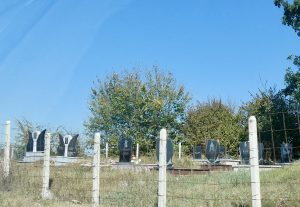
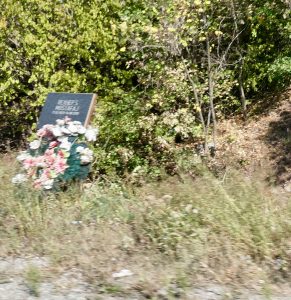
We drove back through the check point and through the little town of Dečan where every block displayed multiple memorials to the dead. It was gut wrenching. The drive out of town then took us through farmlands and a couple small villages before reaching the town of Gjakova (pronounce Jackova) where we would be visiting the bazaar and stopping for some lunch.
Gasi parked the car and I told him I had one mission and one mission only: to find a Christmas ornament. (And yes, I did find an ornament in Macedonia, ironically on the first day in Scopje when we stumbled upon the little music festival and I found a vendor selling little handmade ornaments depicting Macedonian women in traditional costume.)
Anyway, Gasi said there was not a chance I would find an ornament, and I told him unequivocally I would. So with the gauntlet laid, I told Gasi to let me wander for an hour and I would meet him back at the restaurant area of the bazaar. So off I set. Quite frankly, the pickings were very, very slim. Lots and lots of clothing shops, jewelry stores and Kosovo traditional costumes for kids, but no handmade souvenirs.

I thought I had struck the motherload when I came across a woodworker. Sadly, he only made large chests and cradles, no ornaments. I will say, however, he was quite a remarkable guy. He spoke no English, but somehow between pointing and hand gestures, we communicated. The best part was the gentleman showed me a chest he made when he was 15 years old. The chest was to be a gift for his bride when he married. Talk about forward thinking!!
And the chest was simply stunning. Even more remarkable, the chest rested on top of the chest his father made for his mother at the same age. I also learned that he had made two chests for the U.S. Ambassador to Kosovo. I swear if I could have brought one with me on the plane, I would have bought one then and there. Incredibly beautiful work.
So with still no Christmas ornament, I started thinking maybe I was going to be shut out and would have to look elsewhere. I was nearing the end of the road when I spotted a sports and music shop displaying small Çifteli, an instrument similar to a mandolin only with a much longer neck. I walked into the store and there was a small display of tiny Çifteli ornaments. SCORE!!!! I was beside myself. I am pretty sure that the guy in the store thought I was nuts, but I happily paid 2 euros and took my prize back to the restaurant.

Gasi insisted it wasn’t a Christmas ornament, and I told him what the hell else would you have a Çifteli hanging from a string for? Anyway, I am sticking with my story and if I find anything else, I will let you know.
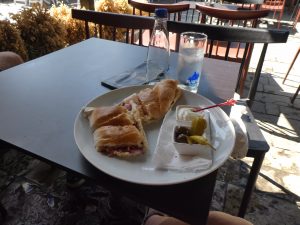
Anyway, I sat down at the outdoor table and ordered what I was told was a Kosovo specialty, spicy meat on fresh bread. Now to date, Macedonia and Albania sorely lack anything approaching spiciness (with the exception of the spicy peppers I ate at the restaurant on Lake Ohrid). As a result, I was not expecting much, but boy was I wrong. First, the meat was super spicy. And that coupled with some melty cheese and an incredibly fresh bun made this sandwich simply superb. I actually went inside the restaurant and told the folks how much I enjoyed the sandwich. It was really, really good.
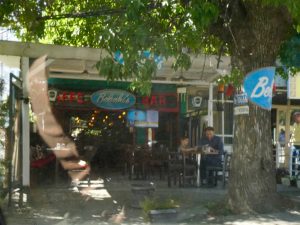
So after lunch, we left town, passings a pub/cafe named Belushi’s (after John Belushi whose parents were ethinic Albanian) and made the half hour ish drive to Pristina (pronounced Prish-tee-na), the capital of Kosovo and the largest city with a population of just about a quarter million people. I was going to be spending two nights in the city to see the sites in and around Pristina. For now, I would relax in my absolutely gorgeous boutique hotel (Hotel Pinocchio) and enjoy the night without roosters crowing.
